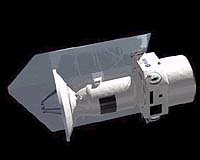 |
Kourou, French Guiana (AFP) May 14, 2009 Europe on Thursday launched two powerful space telescopes, Herschel and Planck, designed to peer into the origins of the Universe and the formation of stars and galaxies. The two observatories, together costing some 1.8 billion euros (2.44 billion dollars), were hurled into the skies at 1312 GMT by an Ariane 5 ECA heavy rocket from the European Space Agency's launch pad at Kourou, French Guiana. "ESA is en route to the origin of the Universe," declared Jean-Jacques Dordain, the agency's director general. "Let's imagine that we shall see the first light after the 'Big Bang'," he added. Around half an hour after lift-off, the two spacecraft successfully separated from the rocket's upper stage to go their independent ways, prompting a wave of relieved applause to erupt at launch control. The pair then sent an all-is-well radio signal back to Kourou. "Both satellites are alive!" ESA said in a Twitter update. Over the coming weeks, the two satellites will undergo testing as they each gradually deploy to orbits around the so-called second Lagrangian point (L2). This is a location around 1.5 million kilometres (937,000 miles) from Earth in the direction opposite to the Sun. Herschel, described by ESA as the largest, most powerful infrared telescope ever put into space, is designed to look into deep space to explore how stars and galaxies accrete from clouds of gas and dust. It boasts a primary mirror of 3.5 metres (11.37 feet) across, more than four times larger than any other previous infrared space telescope. This huge collector will reflect its light to three spectrometers and cameras cooled by liquid helium to just above -273.15 degrees Celsius (-459 Fahrenheit), also known as absolute zero, to prevent residual heat from ruining the observations. Planck is a 1.5-metre (4.8-feet) telescope with two ultra-sensitive detectors of Cosmic Microwave Background (CMB) radiation -- the backwash of energy from the "Big Bang" scientists say created the Universe around 14 billion years ago. It will measure minuscule differences in CMB temperature across patches in space. With luck, Planck will provide "the sharpest picture ever" of the Universe, providing a snapshot of cosmic physics when the heavens were just 380,000 years old, ESA says. It could help explain why the Universe's expansion is accelerating and throw up clues on "dark matter," which is believed to account for around 23 percent of all the stuff in the Universe but has never been directly detected. The two observatories are Europe's biggest-ever investment in space astronomy. They were to have been taken aloft on April 16, but this was postponed to May 6 before being postponed again in order to make checks on the launcher. Share This Article With Planet Earth
Related Links Space Telescope News and Technology at Skynightly.com
 Trio of space telescopes set to give astronomy a quantum push
Trio of space telescopes set to give astronomy a quantum pushParis (AFP) May 14, 2009 Mankind's quest to peer ever deeper into the cosmos gained a massive boost on Thursday as Europe released two mighty observatories into space and the US pressed ahead with refurbishing the acclaimed Hubble telescope. The two European instruments comprise Herschel, the most powerful infrared space telescope ever built, and Planck, designed to delve into the remnants of the "Big Bang" that cre ... read more |
|
| The content herein, unless otherwise known to be public domain, are Copyright 1995-2009 - SpaceDaily. AFP and UPI Wire Stories are copyright Agence France-Presse and United Press International. ESA Portal Reports are copyright European Space Agency. All NASA sourced material is public domain. Additional copyrights may apply in whole or part to other bona fide parties. Advertising does not imply endorsement,agreement or approval of any opinions, statements or information provided by SpaceDaily on any Web page published or hosted by SpaceDaily. Privacy Statement |